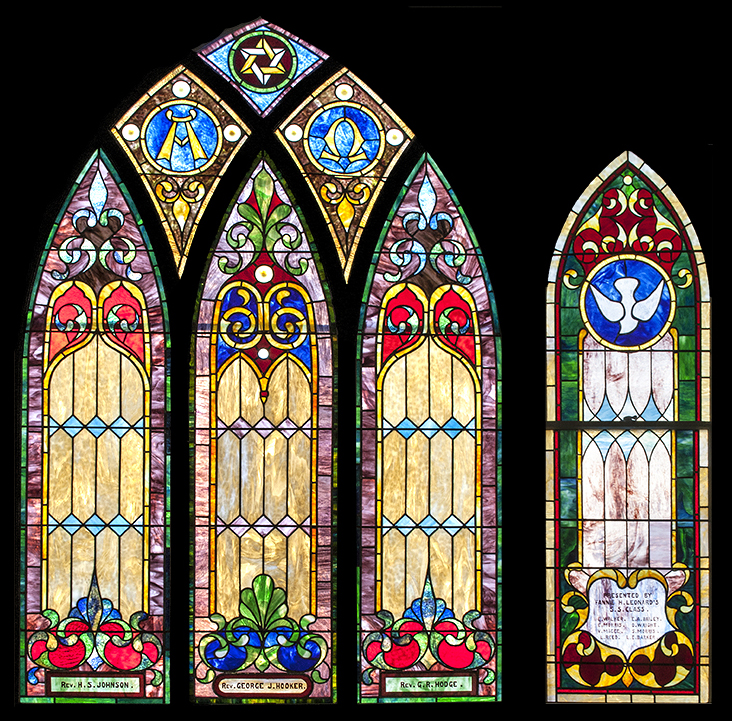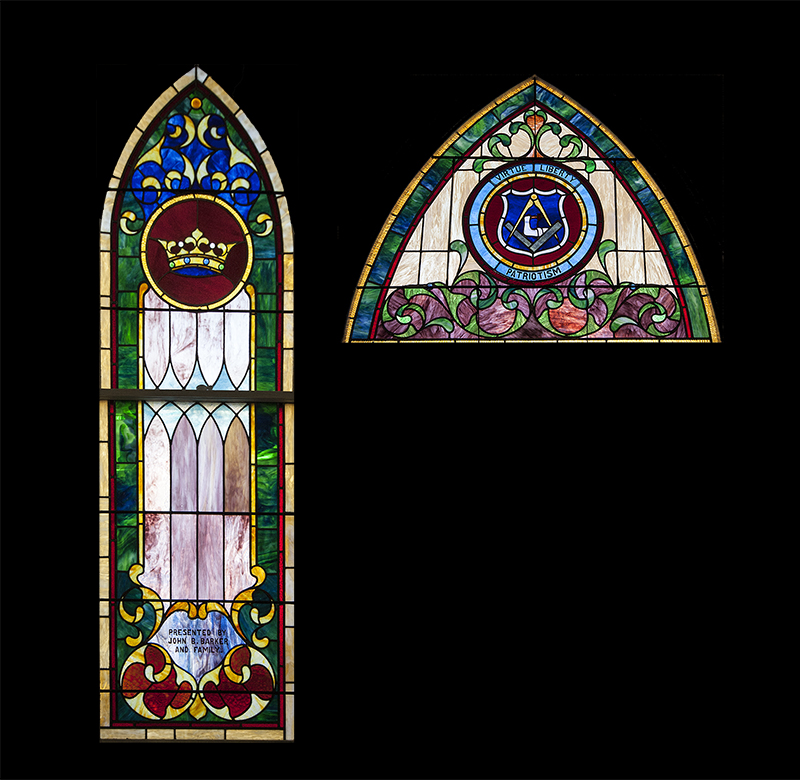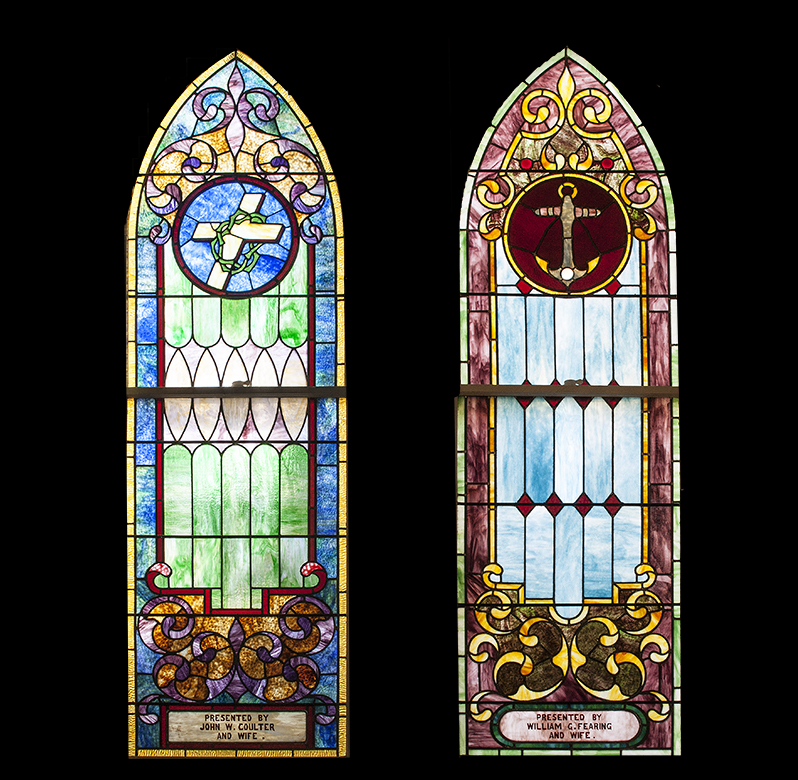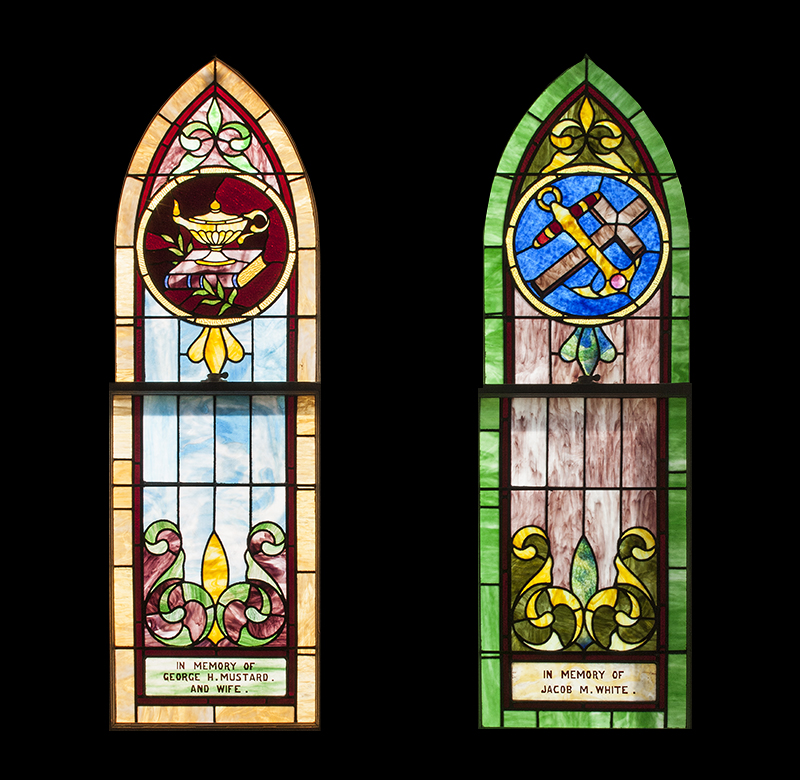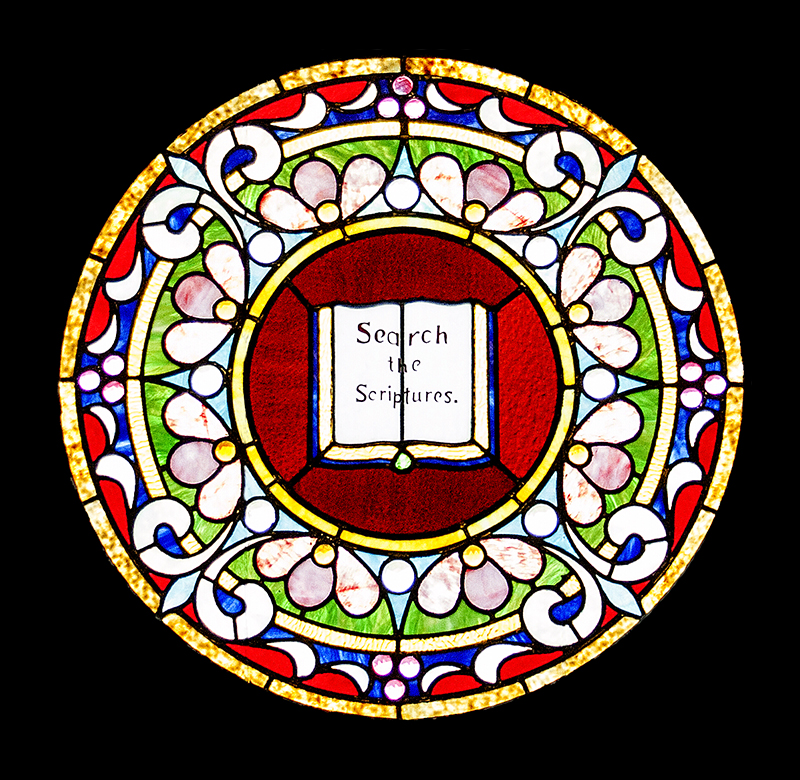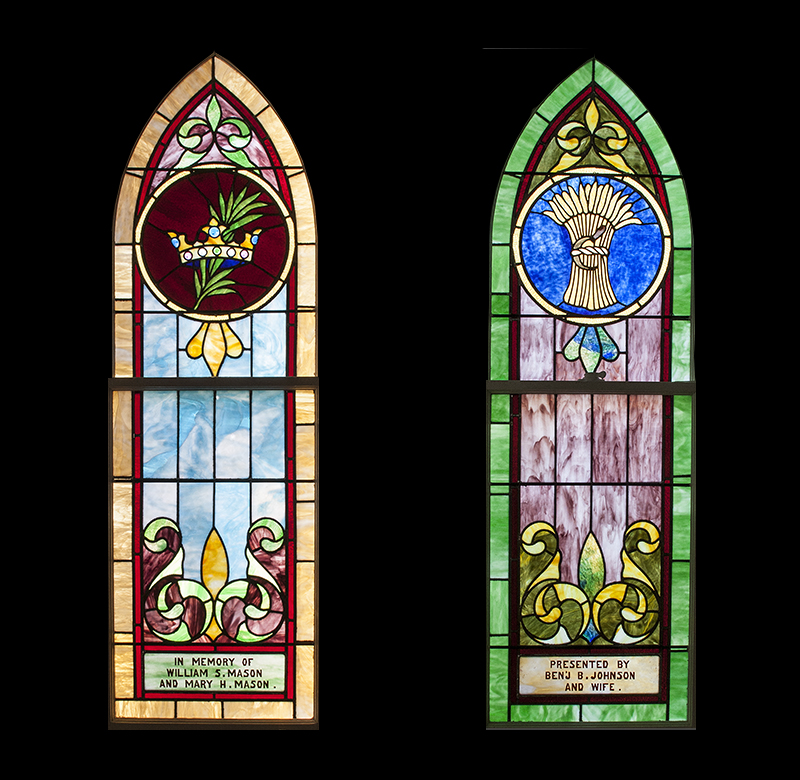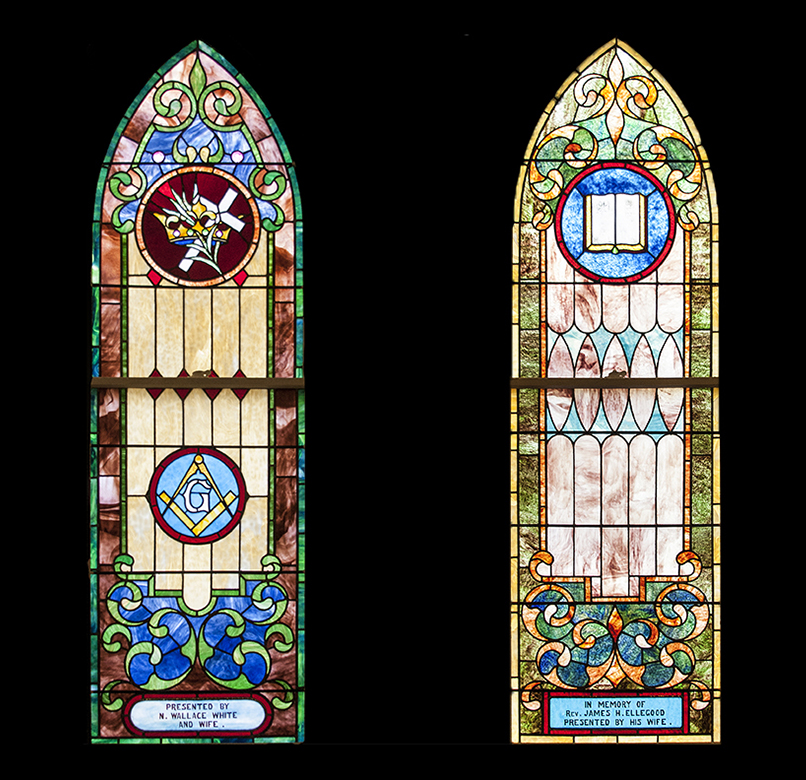Introduction
Any visitor to the Lydia B. Cannon Museum will be struck by how much of the interior is dominated by its stained glass windows. The main hall of the church and its semicircular chancel are relatively small spaces, and the windows fill the walls almost completely: twenty in the main hall and chancel of this former Methodist Protestant Church, and two more in the Donovan Annex, all but two of these in a Gothic arch shape. There are also three more round windows in a compass rose design: in the bell tower, in the attic over the main hall, and in the attic over the Annex. These last three are only visible from the outside of the building unless one has access to these locations.
If the visitor’s idea of church windows has been formed from the figurative biblical scenes in the stained glass of the great European cathedrals, or the abstracted Christian representations in modern churches, the windows in the LBC Museum building will seem surprisingly spare, even austere. There are no representations of saints, apostles, prophets, or Jesus. Instead, most of each window is opalescent glass in simple patterned designs commonly used in the late 19th and early 20th century.
There are, however, two elements present in almost all of the windows of the main hall, chancel, and annex: a name honoring a donor or in memory of someone designated by the donor, and a symbolic emblem. The stories of the individual donors are told in the articles under the People of the Windows heading; this article is about the symbols.
The symbols, at once familiar but with a vague strangeness to them, tell a great deal about the congregation’s values in 1906. The familiar icons are the Cross, the Holy Bible, and the Anchor, but there are crowns, sprigs of some kind of leafy plant, scepters, an oil lamp, wheat sheaves, the compass and square combination, even an arm and hammer. Understanding their meaning requires some knowledge of Freemasonry, for that is the origin of the majority of the symbols, and to some extent, the importance of fraternal orders in early 20th century Milton.
There were several fraternal orders established in Milton of 1906, including the Freemasons, the Heptasophs, the Odd Fellows, and the Improved Order of Red Men – to name a few. If one did any kind of business, professional service or trade in Milton, he would do well to join one or more of these orders. Aside from charitable work for the community, fellowship and some material benefits such as insurance, meetings of the fraternal orders provided opportunities to establish and cement business relationships – like the golf course of today. Additionally, in 1906 there was no perceived conflict in being a Freemason and being a devout Methodist, as has surfaced in more recent times; clergymen were often members of these orders.
The Freemasonry presence in Milton dates back to 1848, when Endeavor Lodge No. 17 was established; the original building on the corner of Chestnut and Mill Streets that housed the lodge is still actively used by the order. One person memorialized on a window – John H. B. Mustard – was a “Worshipful Master,” or elected head of the lodge, four times. He and N. Wallace White both have the classic Masonic emblem of the “compass and square” in the middle of their windows, which can be taken to mean there was a strong connection between them and the order.
What follows is a discussion of the symbols and their significance to Freemasons and the clergy.
East Wall
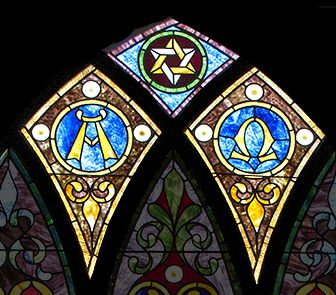 The group of six windows on the East Wall honors three former ministers of the Milton M. P. Church: H. S. Johnson, George J. Hooker, and George R. Hodge. The three smaller windows of the group of six, honoring three former ministers of the Milton M. P. Church, include a symbol resembling a Star of David but actually associated with the Royal Arch Degree of Freemasonry, while the two windows to its left and right contain the Greek letters Α (alpha) and Ω (οmega); these refer to a passage in Revelation 1:18, “I am the alpha and the omega,” variously interpreted as an appellation of God or Jesus Christ.
The group of six windows on the East Wall honors three former ministers of the Milton M. P. Church: H. S. Johnson, George J. Hooker, and George R. Hodge. The three smaller windows of the group of six, honoring three former ministers of the Milton M. P. Church, include a symbol resembling a Star of David but actually associated with the Royal Arch Degree of Freemasonry, while the two windows to its left and right contain the Greek letters Α (alpha) and Ω (οmega); these refer to a passage in Revelation 1:18, “I am the alpha and the omega,” variously interpreted as an appellation of God or Jesus Christ.
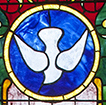 The “Sunday School” window to the right of the group features a white dove of peace on a circular blue field, a symbol typically representing the Holy Spirit. My belief is that, because this window was funded entirely by Fannie Leonard and the eight girls of her Sunday school class, and not their fathers or husbands, this particular emblem has no direct or indirect association with Freemasonry – an all-male institution in those years.
The “Sunday School” window to the right of the group features a white dove of peace on a circular blue field, a symbol typically representing the Holy Spirit. My belief is that, because this window was funded entirely by Fannie Leonard and the eight girls of her Sunday school class, and not their fathers or husbands, this particular emblem has no direct or indirect association with Freemasonry – an all-male institution in those years.
Vestibule
The smaller of the two windows in the vestibule (the “JOUAM” window), at right, sits above the main entrance on the east wall; the larger (“Barker”) window sits to the left of the entrance, on the north wall.
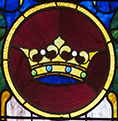 The “Barker” window contains a gold crown on a red or maroon field. The crown is an important Masonic symbol and appears in several of the windows, in several variations including the cross portate (cross through crown). As a symbol it is also used by youth groups affiliated with the Freemasons, such as the Order of DeMolay, but these affiliates were founded years after the windows were constructed.
The “Barker” window contains a gold crown on a red or maroon field. The crown is an important Masonic symbol and appears in several of the windows, in several variations including the cross portate (cross through crown). As a symbol it is also used by youth groups affiliated with the Freemasons, such as the Order of DeMolay, but these affiliates were founded years after the windows were constructed.
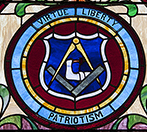 The “Jr. OUAM” window is a truncated version of the tall windows using their design motifs and pointed arch style. The emblem of the Junior Order of United American Mechanics appears within the window, and incorporates the Masonic compass and square with the flexed arm on a shield. The words VIRTUE, LIBERTY and PATRIOTISM are cardinal values of the OUAM.
The “Jr. OUAM” window is a truncated version of the tall windows using their design motifs and pointed arch style. The emblem of the Junior Order of United American Mechanics appears within the window, and incorporates the Masonic compass and square with the flexed arm on a shield. The words VIRTUE, LIBERTY and PATRIOTISM are cardinal values of the OUAM.
The OUAM originated with the anti-immigrant “Know Nothings” of the 1840’s, when American workers perceived themselves as losing out in the competition for jobs with German and Irish immigrants. After the Civil War, the organization dropped its nativist stance and became yet another fraternal organization providing insurance benefits to its members. The Junior OUAM was founded as a youth auxiliary but grew much more popular than the parent organization, from which it seceded and which it finally absorbed. Milton’s chapter #16 was organized in 1894 and included a good number of local tradesmen. Their meeting place was in a building on Front Street. Members of the Milton chapter often attended either of the Methodist churches as a body.
South Wall
The south wall once consisted of four windows; two were moved to the east wall of the Annex after the renovations of 2006. The remaining two are the “Coulter” and the “Fearing.”
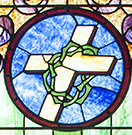 The “Coulter” window has a variation of the cross portate in which the cross passes through a crown, but a crown of thorns, a reference to the Passion of Christ as well as a symbol associated with the Freemasons, thought to have originated with the Knights Templar.
The “Coulter” window has a variation of the cross portate in which the cross passes through a crown, but a crown of thorns, a reference to the Passion of Christ as well as a symbol associated with the Freemasons, thought to have originated with the Knights Templar.
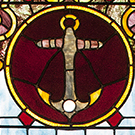 The “Fearing” window bears an anchor, which appears in several other windows as well. At one level, the anchor is an obvious symbol of the shipbuilding industry in Milton, but it is also a Christian symbol indicating the grounding of an individual in faith and hope; the reference is possibly to Hebrews 6:19, “We have this hope as an anchor for the soul, firm and secure.” Lastly, it is a Masonic symbol of well-founded hope.
The “Fearing” window bears an anchor, which appears in several other windows as well. At one level, the anchor is an obvious symbol of the shipbuilding industry in Milton, but it is also a Christian symbol indicating the grounding of an individual in faith and hope; the reference is possibly to Hebrews 6:19, “We have this hope as an anchor for the soul, firm and secure.” Lastly, it is a Masonic symbol of well-founded hope.
North Wall
The north wall of the church retains its original length and has four windows in it: “John Mustard” in memory of John H. B. Mustard (far left), presented by his wife; “Mary” in memory of Mary E. M. Atkins (second from left), presented by her parents; “Annie” in memory of Annie M. Morris (third from left); and “Betts” presented by James A. Betts and family (far right).
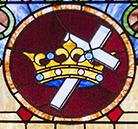
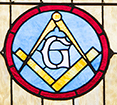 In the “John Mustard” window we see not only a cross portate at the top, but the Masonic symbol of compass over square with G in the center (for the “Great Architect” or “Geometry”) prominently in the lower part of this window, for a man who was a four-time “Worshipful Master” of Endeavor Lodge.
In the “John Mustard” window we see not only a cross portate at the top, but the Masonic symbol of compass over square with G in the center (for the “Great Architect” or “Geometry”) prominently in the lower part of this window, for a man who was a four-time “Worshipful Master” of Endeavor Lodge.
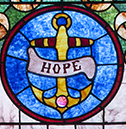 The “Mary” window contains the anchor symbol with the word HOPE on a banner across it, a symbol that is at once secular, Masonic, and Christian.
The “Mary” window contains the anchor symbol with the word HOPE on a banner across it, a symbol that is at once secular, Masonic, and Christian.
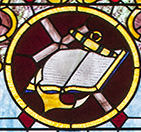 A cross, anchor, and Book of Scripture appear in the “Annie” window, all three of which are Masonic and Christian symbols.
A cross, anchor, and Book of Scripture appear in the “Annie” window, all three of which are Masonic and Christian symbols.
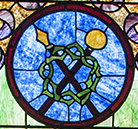 A spear, crown of thorns and scepter appear in the “Betts” window; the spear and crown of thorns are associated with the Crucifixion and the Passion of Christ, while the scepter, representing the “King of Heaven,” is frequently found in Masonic symbols together with a crown or crown of thorns.
A spear, crown of thorns and scepter appear in the “Betts” window; the spear and crown of thorns are associated with the Crucifixion and the Passion of Christ, while the scepter, representing the “King of Heaven,” is frequently found in Masonic symbols together with a crown or crown of thorns.
West Wall, Left
The west wall of the building forms an apse behind the chancel (the area where the altar is located). It contains five windows, including a large round one at the center. This section of the essay will focus on the two windows on the left side of the wall: the “Jacob White” and the “George Mustard.” The pointed arch windows on the west wall are both shorter and narrower compared to the pointed arch windows on the south, east, and north walls, no doubt because of their location in the crowded chancel.
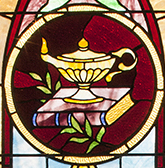 Three Masonic symbols appear on the “George Mustard” window: the sprig of acacia, scriptures, and on top of both the “Lamp of Knowledge”. The acacia plant, for Freemasons, is a symbol of immortality and innocence as they have interpreted it from Hebrew scripture. The Lamp represents the series of meetings between a Masonic Brother with a candidate/new member, where the Brother serves as mentor for a period of one year.
Three Masonic symbols appear on the “George Mustard” window: the sprig of acacia, scriptures, and on top of both the “Lamp of Knowledge”. The acacia plant, for Freemasons, is a symbol of immortality and innocence as they have interpreted it from Hebrew scripture. The Lamp represents the series of meetings between a Masonic Brother with a candidate/new member, where the Brother serves as mentor for a period of one year.
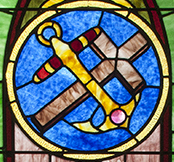 The cross and anchor appear separately in other windows, but these two Masonic and Christian symbols appear together in the “Jacob” window. The anchor is also a possible reference to the importance of the maritime industry in Milton.
The cross and anchor appear separately in other windows, but these two Masonic and Christian symbols appear together in the “Jacob” window. The anchor is also a possible reference to the importance of the maritime industry in Milton.
West Wall, Center
The round window at center of the west wall is unlike any of the others in shape, motif, or ornamentation There is no indication of who presented it, but at its center there is a partial quotation from John 5:39-47, “Search the scriptures; for in them ye think ye have eternal life: and they are they which testify of me.” Freemasons search the scriptures and are therefore always ready to give a reason for their faith and practice. One possibility is that this window was a gift of the Endeavor Lodge.
West Wall, Right
The remaining two windows on the apse wall are the “Mason,” presented in memory of William and Mary Mason, and the “Johnson,” presented by Benjamin B. Johnson and his wife.
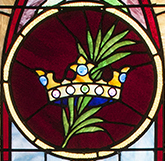 The “Mason” window contains a crown in combination with an acacia sprig, Masonic symbols which we have already seen in some of the other emblems thus far.
The “Mason” window contains a crown in combination with an acacia sprig, Masonic symbols which we have already seen in some of the other emblems thus far.
At first glance, 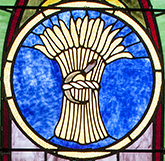 the bundle of wheat with sickle on the “Johnson” window appears to be a tribute to the farming industry in Sussex County, where wheat fields are still found in great numbers. We know, however, a bundle of wheat sheaves were one of many pagan symbols and rituals appropriated by the church fathers in the early centuries of Christianity. In fact, one of the more popular gospel hymns in America was “Bringing in the Sheaves.”
the bundle of wheat with sickle on the “Johnson” window appears to be a tribute to the farming industry in Sussex County, where wheat fields are still found in great numbers. We know, however, a bundle of wheat sheaves were one of many pagan symbols and rituals appropriated by the church fathers in the early centuries of Christianity. In fact, one of the more popular gospel hymns in America was “Bringing in the Sheaves.”
The importance of the harvest to the farming population around Milton in the last years of the 19th century was huge, and farming still remains a major economic activity in Sussex County; the county flag today, designed in the early 1970’s, has a bundle of wheat emblazoned in its center. The Milford Chronicle of July 3, 1891 describes a special harvest service held in the Milton M. P. Church in which the church itself was decorated with sheaves of wheat, sickles, and a grain cradle, with appropriate music and sermon.
Donovan Annex
The two windows on this page are on the east wall of the Donovan Annex, a new structure built during the major renovations of 2004 – 2006. The Annex was erected on the site of the Social Hall[1]; the latter, which had fallen into extreme disrepair, was demolished during the 2004 – 2006 renovations. Construction of the Annex and connecting it to the main hall necessitated the relocation of two of the windows on the south wall to the Annex.
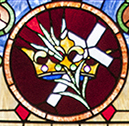
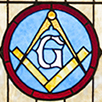 The “Wallace White” window, presented by N. Wallace White, bears two symbols: the Masonic symbol of the cross and crown with sprig of acacia is at the top of the window and, like the “John Mustard” window, the Masonic symbol of compass over square with G (for the Great Architect or Geometry) occupying a prominent position at the center of the window. This would suggest an important role played by N. Wallace White in the Endeavor Lodge, possibly as an elected officer (but not the top office of “Worshipful Master”).
The “Wallace White” window, presented by N. Wallace White, bears two symbols: the Masonic symbol of the cross and crown with sprig of acacia is at the top of the window and, like the “John Mustard” window, the Masonic symbol of compass over square with G (for the Great Architect or Geometry) occupying a prominent position at the center of the window. This would suggest an important role played by N. Wallace White in the Endeavor Lodge, possibly as an elected officer (but not the top office of “Worshipful Master”).
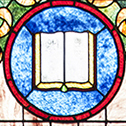 The “Ellegood” window, in memory of the Rev. James H. Ellegood, has an open Holy Bible at the top. The words are faded and barely legible. Like the “Dove of Peace” and the “Bundle of Wheat” symbols on other windows, the Holy Bible icon has no special connection to Freemasonry, other than the fact that it is Holy Scripture, which Freemasons are exhorted to read. We have no evidence that Rev. James Ellegood was a Freemason, and his wife Rebbecca, who funded the window, certainly would not have any ties to that organization; therefore, we can conclude with some degree of confidence that this emblem was purely Christian.
The “Ellegood” window, in memory of the Rev. James H. Ellegood, has an open Holy Bible at the top. The words are faded and barely legible. Like the “Dove of Peace” and the “Bundle of Wheat” symbols on other windows, the Holy Bible icon has no special connection to Freemasonry, other than the fact that it is Holy Scripture, which Freemasons are exhorted to read. We have no evidence that Rev. James Ellegood was a Freemason, and his wife Rebbecca, who funded the window, certainly would not have any ties to that organization; therefore, we can conclude with some degree of confidence that this emblem was purely Christian.
—————————————————————-
[1] Initially a separate structure, the Social Hall building was acquired in 1925 and was connected to the church in 1946 through a narrow enclosed corridor. The narrowness of that connecting structure allowed all the windows on the South Wall to remain in place.

